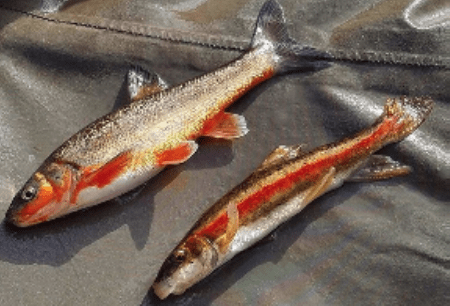
Species
Rio Grande sucker (Catostomus plebeius)
Rio Grande chub (Gila pandora)
Principal biologist(s)
Carter Kruse, Eric Leinonen
Project Locations
Las Animas Creek, Seco Creek and Palomas Creek, Ladder Ranch, NM
Costilla Creek, Vermejo Park Ranch
Conservation Problem
Range-wide declines of both Rio Grande sucker (RGS) and Rio Grande chub (RGC) have occurred due to habitat and stream flow alterations; predation and competition from non-native fishes; loss of genetic variability; and vulnerability to stochastic events.
Conservation Status
– Both RGS and RGC were petitioned for listing under the ESA in 2014
– RGS are listed as an endangered species in Colorado
– Both species are considered Species of Greatest Conservation Need by the NMDGF and COPW
Project Goals & Objectives
Our overall goal is to conserve and restore self-sustaining populations of RGS and RGC on Turner Ranches and surrounding landscapes to enhance the conservation status of both species. We also aim to contribute information on RGS and RGC to the scientific community to improve our understanding of these species and their conservation status.
– TBD will maintain populations of RGC and RGS in at least three streams on the Ladder Ranch.)
– Restoration will be attempted at one site at Vermejo Park Ranch (Costilla Creek)
– TBD will work with State and Federal partners to advance the overall species conservation and recovery by implementing research and monitoring opportunities that result in publication of reviewed scientific articles.
Project Background
RGS and RGC co-evolved along with Rio Grande cutthroat trout (see Section 10) in the Rio Grande River basin. On Turner properties management and conservation of these two species will be considered and occur simultaneously.
Historically RGS occurred in the Rio Grande (primarily), Mimbres, and Gila drainages. RGC occurred in the Rio Grande, Pecos, and Canadian drainages and an isolated population in the Davis Mountains in Texas. The Ladder and Vermejo ranches contain large, high quality stream habitat within the historical range of RGC and RGS. When purchased by the Turner organization in 1992, three streams on the Ladder Ranch – Palomas, Seco, and Las Animas creeks – contained both RGS and RGC (as reported in early biodiversity reports). These populations were confirmed by TBD during electrofishing surveys in summer 2003. Although all three streams are tributaries to the Rio Grande River and were historically connected, water diversion, mainstem dams, and non-native fish populations have now isolated these populations from each other. RGS or RGC have never been found in Costilla Creek (tributary to Rio Grande) on Vermejo Park Ranch. We are unsure if this is because the elevation is too high or due to extirpation from predation by non-native trout (Costilla Creek now restored to Rio Grande cutthroat trout; see Section 10).
In summer of 2003, two separate fires burned approximately 2,266 and 1,817 hectares of the Gila National Forest in the headwaters of North Seco and Palomas creeks, respectively. Although these fires occurred outside of the boundaries of the Ladder Ranch, summer monsoons resulted in a series of ash and sediment flow events that dramatically affected RGS and RGC in both drainages. In Seco Creek RGS and RGC declined 98% and 80%, respectively. Effects in Palomas Creek were similar. The populations recovered relatively quickly and by 2007-08 densities were similar to 2003 (Fig. 12.1). This severe population bottleneck event led TBD to partner with the University of New Mexico to investigate genetic diversity of these isolated RGS populations. The results of that work were published in the journal Conservation Genetics in 2015.
In summer 2013, the Silver Fire burned 138,698 acres of the Gila National Forest, including large portions of the Las Animas and Seco creek headwaters. Subsequent monsoon rains led to several significant ash and debris flows in these two creeks (Fig. 12.2). Palomas Creek was less affected. Fisheries surveys by TBD from 2014-16 confirmed the extirpation of RGS and RGC from Seco Creek, and the loss of RGS and near extirpation (99% decline) of RGC in Las Animas Creek.
In 2016 TBD received a State Wildlife Grant from NMDGF to develop eDNA markers for detecting RGS and RGC in the environment with a water sample. TBD collected genetic samples from 30 RGC and 17 RGS populations in New Mexico and Colorado, and worked with the National Genomic Center for Fish and Wildlife Conservation at the University of Montana, to develop and test the eDNA markers.
